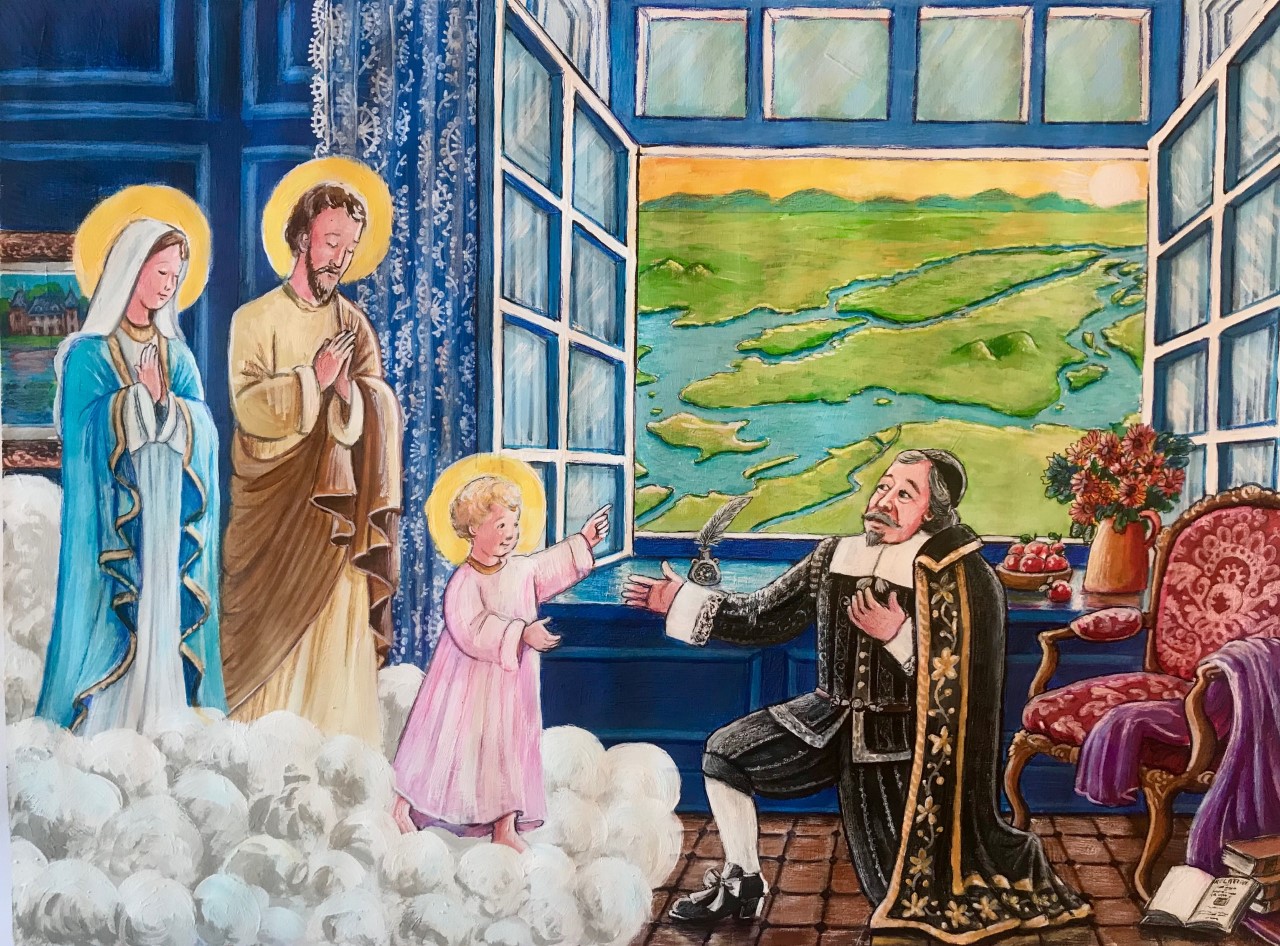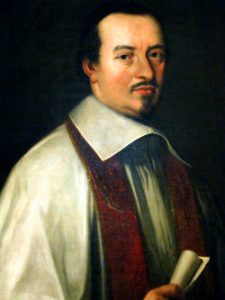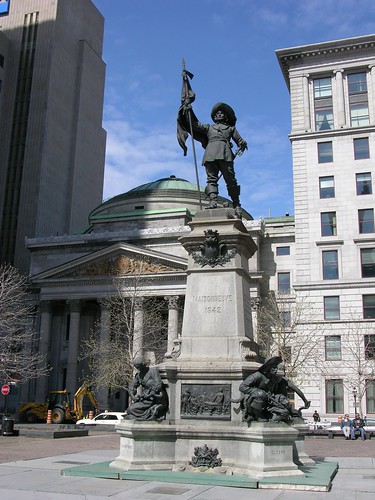L’origine mystique de Montréal
Vénérable Jérôme le Royer et la fondation des hospitalières:
Les Jésuites de Nouvelle-France avaient l’habitude d’envoyer un journal annuel qui s’intitulait Les Relations des Jésuites. Publiées à mesure de leur arrivée à Paris, ces écrits constituaient comme une sorte de roman d’aventures particulièrement apprécié et attendu! Dans toutes les classes de la société on les lisait avidement et on peut dire que cette lecture provoqua à elle seule un grand nombre de départs de gentilshommes, de bourgeois, d’artisans, de cultivateurs, pour le Canada, sans parler des vocations religieuses.
Un gentilhomme de la Flèche, en Anjou, Jérôme Le Royer de La Dauversière, avait un ardent désir de pouvoir faire quelque chose pour l’évangélisation du Canada. À l’approche de ses 33 ans, Jérôme Le Royer se rendit à la chapelle Notre-Dame du chef du Pont de La Flèche à la fête de la Purification. C’était le 2 février 1630. Dans la chapelle, chaque fidèle, son cierge à la main, écoute, recueilli, les profondes paroles du texte liturgique : « Et ta louange s’étend jusqu’aux confins de la terre ».

Jérôme le Royer et sa vision de la sainte Famille
Au moment de la communion, Monsieur de la Dauversière, entendit une voix intérieure, pressante : « Mon fils, consacre-toi, avec ta femme et tes enfants, à la Sainte Famille. Tu fonderas un Ordre de religieuses et tu les consacreras à mon Père nourricier, Joseph. Ces religieuses iront à Montréal, en Canada, et y fonderont l’Hôtel-Dieu. »
En 1633, Jérôme Le Royer est atteint d’une grave maladie et recevra le sacrement des mourants. Durant sa maladie, il en profite pour élaborer son projet de fondation. Il aura des conversations mystiques avec le Christ et écrira plusieurs cahiers de ses dialogues. Grâce à Dieu, il se rétablit de sa maladie.
En janvier 1635, Jérôme se rend à la Cathédrale Notre-Dame de Paris pour y prier la Vierge Marie. Après la communion, pendant sa prière fervente, Jérôme se trouve en présence de la Sainte Famille. Le prenant par la main, Marie le présente à Jésus en disant : « Voici votre serviteur fidèle. » Le Seigneur le reçoit avec bonté et lui dit : « Vous serez désormais mon serviteur fidèle, je vous revêtirai de force et de sagesse, vous aurez pour guide votre ange gardien, travaillez fortement à mon œuvre. Ma grâce vous suffit et ne vous manquera point. »
En 1636, il jette les bases de la confrérie de Saint-Joseph qui deviendra : « L’Institut des Religieuses Hospitalières de Saint-Joseph ». Jérôme Le Royer rénove l’aumônerie Sainte-Marguerite de La Flèche et la transforme en hôpital et lui donne le nom de : « Hôtel-Dieu ». Ces bâtiments délabrés servaient d’abris pour les pauvres et portaient le nom de « Maison-Dieu ».
Éventuellement, la première candidate de la future communauté « Marie de la Ferre » lui est révélée et le premier chapitre des constitutions lui est dicté. Comprenant à la fois ce qui est exigé de lui et ses propres limites, Jérôme s’écriera angoissé : « Hélas ! Seigneur qui suis-je, moi, pour une si grande entreprise ». Il reçoit cette parole de Dieu : « Obéis, obéis, ma grâce te suffit ». Jérôme entre chez lui pour écrire les ordres reçus d’en haut et le premier chapitre des constitutions de la future congrégation qui porte maintenant le nom de : « Religieuses hospitalières de Saint-Joseph ».
Vision de l’île de Montréal:
Des révélations viennent bientôt confirmer la vocation providentielle du pieux laïc: un beau matin de 1640, alors qu’il lisait une de ces Relations « qui parlait fortement de l’île de Montréal, comme étant le lieu le plus propre du pays afin d’y établir une mission et recevoir les sauvages » (Selon L’Histoire de Montréal, par François Dollier de Casson, sulpicien, arrivé lui-même au Canada en 1666), il eut une vision mystérieuse qui lui montra avec une grande netteté, et une parfaite vérité, le site même de Montréal. Monsieur de la Dauversière ne douta pas un seul instant que cette vision ne fût une invitation précise de la Providence. Il s’en ouvrit à son confesseur, le révérend Père Chaveau, recteur du Collège de la Flèche, qui ne fit que le confirmer dans son sentiment, et il fit bientôt partager son enthousiasme mystique à un certain baron de Fancamp, « gentilhomme fort riche qui était depuis peu venu demeurer chez lui, comme dans une école de piété afin d’y apprendre à bien servir Notre Seigneur ».

La rencontre providentielle avec le Père Jean-Jacques Olier :
En 1640, Jérôme le Royer se rendit à Paris accompagné d’un associé, Pierre Chevrier, baron de Fancamp et présenta un projet de mission au père Charles Lalement, procureur des missions des Jésuites au Canada. Le père Lalement fut le premier supérieur des Jésuites à Québec (1625–1629), missionnaire à Québec (1634–1638) et procureur à Paris de la mission de la Nouvelle-France (1638–1650). Jérôme rencontra par la suite Pierre Séguir, chancelier de France, au château Meudon et c’est là qu’il fait la connaissance de l’abbé Jean-Jacques Olier, fondateur du Séminaire de Saint-Sulpice. Monsieur Olier fut aussi tout plein de révélations reçues du ciel sur Montréal. Comme Monsieur de la Dauversière, il a une vision de la situation géographique de l’île et de son avenir providentiel. Olier et Le Royer seront donc animés par le même désir d’évangélisation en établissant une mission en Nouvelle-France.« Montréal, dira-t-il plus tard, où l’on doit bâtir la première chapelle sous le titre de la Sainte Vierge, et une ville chrétienne sous le nom de Ville-Marie, ce qui est une oeuvre d’une merveilleuse importance. »

Jean-Jacques Olier
Ensemble, Le Royer et Olier fondent une société missionnaire qui prend le nom de société « Notre-Dame de Montréal ». En 1640, la société acquiert l’île de Montréal. Le contrat de cession est signé à Vienne le 7 août 1640 et l’acquisition se fit le 7 décembre.
Olier, La Dauversière, Fancamp… La Société du Montréal était virtuellement constituée. On se rendit propriétaire du lieu, qui avait été donné à Jean de Lauson, intendant du Dauphine, et on chercha un chef pour mener à bien l’expédition projetée et fonder l’établissement nouveau. Le Père Jésuite Charles Lalement, qui s’était entremis pour la transaction avec Lauson, interrogé, répondit : « Je suis un brave gentilhomme champenois nommé Monsieur de Maisonneuve, qui a toutes les qualités voulues, et qui ferait bien votre affaire ».
Départ pour la Nouvelle-France:
Paul de Chomedey, sieur de Maisonneuve, était bien l’homme qu’il fallait : mystique, mais réalisateur, idéaliste mais pratique, brave, mais sensé, pieux et vertueux mais compréhensif et charitable, ferme mais juste, on a pu dire de lui qu’il fut un moine laïc. Il quitta La Rochelle avec deux navires en juillet 1641; outre une trentaine de colons (d’autres étaient partis simultanément de Dieppe), et emmenait une Champenoise de sa trempe, Jeanne Mance, de Langres, aussi mordue que lui par l’appel du Canada !
Dans l’Atlantique, la tempête sépara les deux navires; celui qui porta Mademoiselle Mance arriva sur rade de Québec le 8 août, celui où avait pris place Maisonneuve seulement le 20 août. Ce fut pour y trouver dix futurs Montréalistes, venus de Dieppe (ainsi appela-t-on les premiers habitants de Montréal) « déjà occupés à bâtir un magasin sur le bord de l’eau, dans un lieu qui avait été donné par M. de Montmagny pour la Compagnie du Montréal. »
La croix du Mont-Royal:
 Le 17 mai 1642, Maisonneuve, Jeanne Mance et trois autres femmes ainsi qu’une quarantaine d’hommes débarquent sur l’île de Montréal et Ville-Marie est fondée.
Le 17 mai 1642, Maisonneuve, Jeanne Mance et trois autres femmes ainsi qu’une quarantaine d’hommes débarquent sur l’île de Montréal et Ville-Marie est fondée.
Au mois de décembre 1642, le fleuve Saint-Laurent déborda tout à coup, menaçant d’engloutir le fort de Ville-Marie. Monsieur de Maisonneuve promit de porter, seul, au sommet de la montagne, une croix, et de l’y planter, si Dieu préservait l’établissement de l’innondation. Dans la nuit du 25 décembre, les eaux roulaient coup sur coup de grosses vagues qui eurent bientôt rempli les fossés du fort, et qui paraissaient vouloir tout entraîner ; mais elles s’arrêtèrent au seuil de la porte, puis se retirèrent.
Le 6 janvier 1643, jour de la fête des Rois, tout étant prêt, la croix fut bénie solennellement. La procession se mit en marche ; Monsieur de Maisonneuve plaça la lourde croix sur ses épaules, et la porta seul, l’espace d’une lieue. Quand la croix fut en place, le Père Duperron célébra la sainte messe et plusieurs personnes communièrent, nommément madame de La Peltrie. Cette croix, contenant de précieuses reliques, devint l’objet de pieux pèlerinages.
Sources :
Les Français au Canada (du Golfe Saint-Laurent aux Montagnes-Rocheuses), par Cerbelaud Salagnac, Éditions France-Empire, 68, rue Jean-Jacques Rousseau – Paris (1er), 1963.
http://www.cursillos.ca/action/modeles/101m-jerome-le-royer.htm




